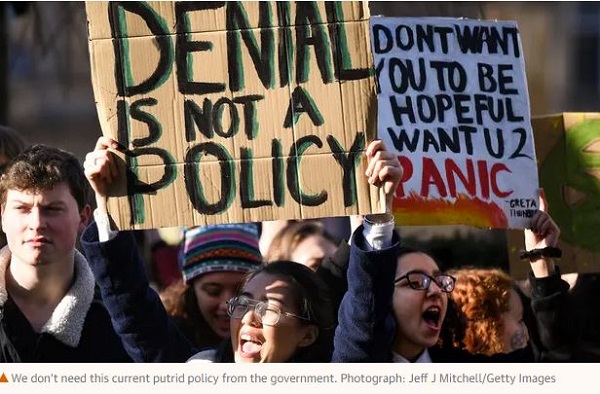
After a summer of record heat and wildfires, the Australian people along with business and industry are looking for concrete, responsible climate policies.
-
Business and consumer groups have accused Prime Minister Scott Morrison of “nakedly political pork barrelling” and “an egregious lack of process” over $3.5 billion in energy announcements.
That’s what we got according to Ben Potter at the AFR.
I think it’s worse than that, but lets start with a few inconvenient graphs from Jacob Greber’s The government thinks we’re idiots and is not serious about reducing emissions:
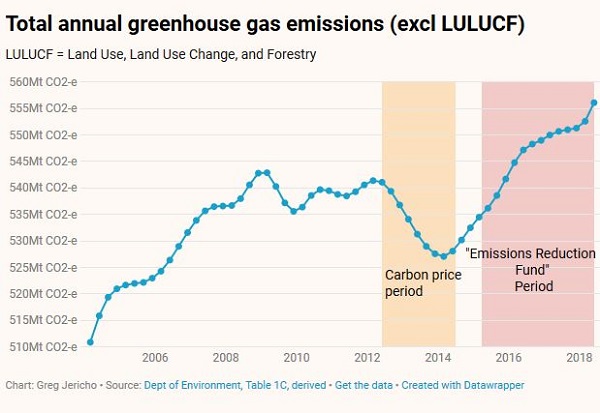
The Government of course includes LULUCF (Land use, land-use change, and forestry) which includes land-clearing in Queensland which is big enough to distort the figures. You can see why the Government chose 2005 as a starting point in this graph, from its own environment department last year:
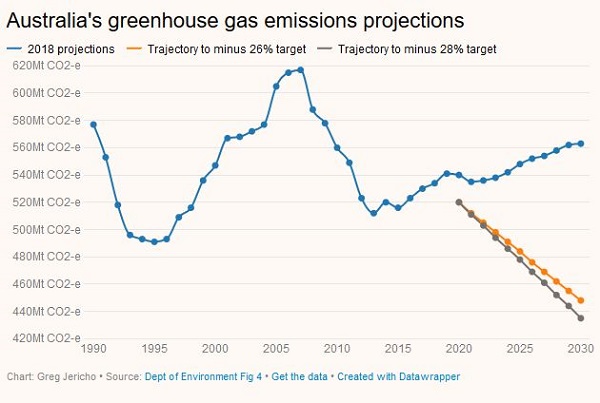
In a post in October last year National emissions inventory scam(s) I explained the cherry-picking with the baseline, and showed this graph:
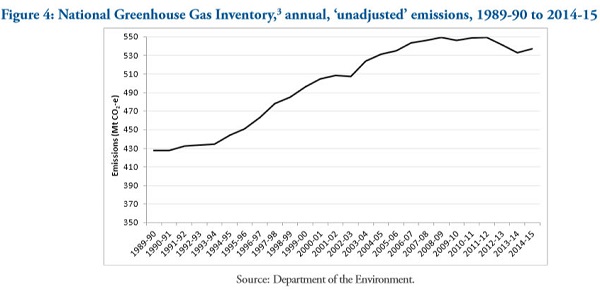
Then the Coalition included LULUCF which magically turned an increase 27.0% (113.4 Mt CO2-e) above 1990 levels into a 9.3% decrease as shown in this graph:
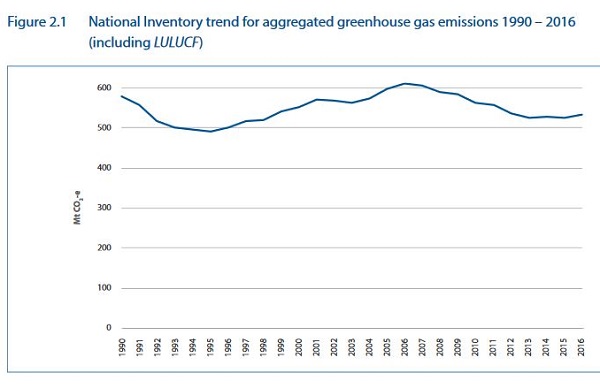
So our Kyoto response was based on a large scam.
In the post I said:
-
The only way we’ll get them down by 26% by 2030 is by changing the rules of the game, which is where the political rhetoric is going.
I thought the Coalition would simply point to the per capita and emissions intensity data. They’ve gone way better than that by simply cutting the task nearly in half. Here’s the graphic, from Phillip Coorey in the AFR:
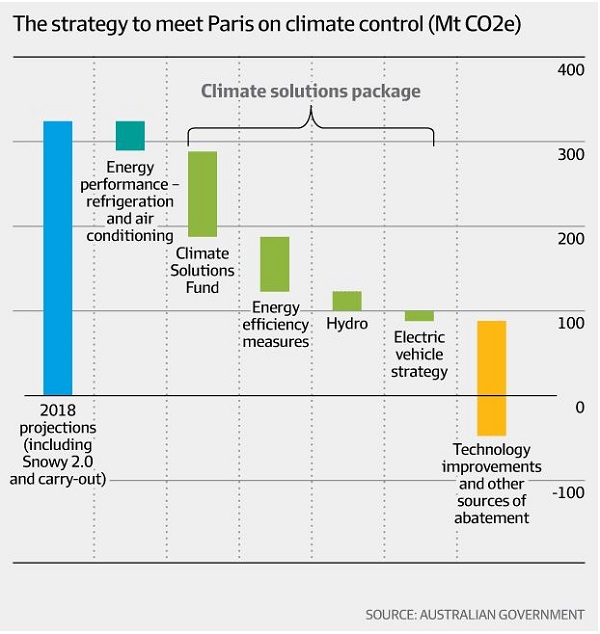
Here’s an enhanced version from a Dylan McConnell tweet:
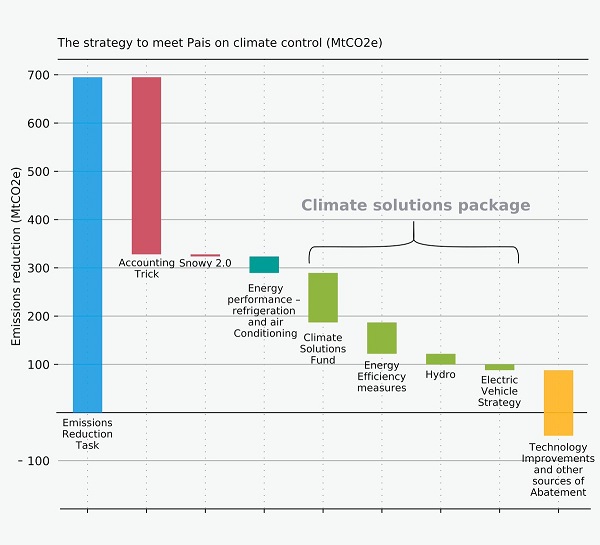
The magic of ‘Kyoto credits’ and Snowy 2.0 have reduced the task by about half.
Other countries are discarding their Kyoto credits, and it raises the issue of whether Labor is going to use the credits to achieve its 45% target.
In this article we have:
Speaking to Sky News, the “minister for lowering electricity prices” said it would be irresponsible for Labor not to use the carryover credits.
“[Labor’s 45% target] will be economy-wrecking if they do use the carryover,” Taylor said. “It will apocalyptic if they don’t use it.
Unfortunately the BCA has bought into the notion that Labor’s target of 45% reduction by 2030 will be “economy wrecking”. It comes from Brian Fisher’s absurd modelling that puts the cost to the economy at $472 billion. Fisher has campaigned vigorously against climate action and is the Minerals Council’s favourite modeller.
Angus Taylor and others accepting his work ignore the fact that Fisher’s analysis claimed that the Coalition’s own emissions target of 26 to 28% would cost around $70 billion, preferring a separate report from the ANU that said Australia would meet its emissions target early and at no extra cost.
Almost universally, the Coalition’s climate policy has had a terrible reception. Giles Parkinson at RenewEconomy said it puts lipstick on Tony Abbott’s pig.
Ben Potter at the AFR says:
- Business and consumer groups have accused Prime Minister Scott Morrison of “nakedly political pork barrelling” and “an egregious lack of process” over $3.5 billion in energy announcements.
Peter Hannan at the SMH pointed to Morrison’s pea-and-thimble trick.
Katharine Murphy at The Guardian said If the Coalition has had a climate epiphany, I’m Beyoncé.
John Menadue at Pearls and Irritations republished Giles Parkinson’s piece, and tells us that the National Party remains solidly in the column of climate sceptics and is dudding country people on climate change, the NBN and more.
Paul Bongiorno at the New Daily reminds us:
- Malcolm Turnbull once famously described Direct Action as “a recipe for fiscal recklessness on a grand scale and a fig leaf to cover its determination to do nothing”.
The same can be said of the new package.
Sophie Vorrath reports Scientists slap down Australia government over fake climate claims:
-
A group of 28 climate scientists, academics and former heads of energy companies on Monday released a joint statement to correct the record, and remove any ambiguity on the subject:
-
– Australia is NOT on track to meet its 2030 emissions reduction target;
– Even if it was (it’s not), the target itself is woefully inadequate for what science says must be done to avert dangerous climate change.
Climate Councillor Greg Bourne explained it to Fran Kelly on the ABC radio:
when Australia used these credits back in the context of Kyoto, it was bad enough.
“Using those credits right now, and trying to bring them forward, will be seen by every other country as – this is just disgusting, just disgusting,” he said.
Here’s a summary of the announcements from Ben Potter’s article:
Mr Morrison virtually anointed his fourth big ticket energy project for the week in Tasmania on Wednesday, backing feasibility studies into three pumped hydro projects in Tasmania and saying that if they pass muster and the government is re-elected it will underwrite them in two years’ time.
On Monday and Tuesday Mr Morrison committed $1.4 billion to Snowy Hydro’s $4.5 billion Snowy 2.0 expansion, $2 billion to reboot its Emissions Reduction Fund for another 10 years, and $56 million towards building the Marinus Link – a second high voltage interconnector that aims to connect Tasmania’s abundance of hydro resources with the mainland Victoria.
On Thursday energy minister Angus Taylor will unveil $50 million in new spending to help small firms and community bodies cope with high energy costs. They will be able to tap up to $25,000 per applicant to spend on efficiency boosting equipment, management and assessment systems and – form community organisations – solar panels.
Giles Parkinson and Sophie Vorrath have a neat piece 10 things to know about Scott Morrison’s so-called climate “pivot”. I’ll comment on two.
Climate Solutions Fund
- The Climate Solutions Fund is the new name for Mr Abbott’s Emissions Reduction Fund (ERF). Mr Morrison is pledging $2 billion over 10 years for this stunt. Mr Abbott’s ERF is on track to burn through $2.55 billion in five years.
Just to make the maths obvious, the annual spend is being cut from an average of $510 million to $200 million.
Ian MacKenzie, Senior Lecturer in Economics at The University of Queensland, wrote about the EFR’s failings last year.
Parkinson and Vorrath say it has been used for Rio Tinto to build a diesel generator, for others to do gas.
- the ERF is also being used to prop up fossil fuels, with funding going towards a fossil fuel power plant (that would have been built anyway) for one of the world’s biggest gold mines. This is justified on the grounds that the new fossil fuel power plant will be ‘cleaner’ than the one it will replace.
Now as Michelle Grattan details farmers will receive assistance with revegetation and drought-proofing, and local communities will receive help to reduce waste and boost recycling.
‘Climate solutions’ is coming to represent an ATM for just about anything in the bush.
See also Coalition’s carbon reduction fund needs to be overhauled, say energy experts by Mark Ludlow and Ben Potter.
The fascination of pumped hydro
It seems that pumped hydro is the new black, headline-grabbing glamour projects and acceptable to the Coalsheviks. Ben Potter has written at least three articles in the AFR questioning the wisdom and viability of the Coalitions plunge into large-scale hydro:
-
Morrison pumps hydro over coal with Phillip Coorey
The business case for Snowy 2.0 has never been released, it being commercial in confidence. They are claiming an 8% internal return, but only after the Commonwealth is tipping in an extra $1.4 billion. This does not come from the budget, because it is a commercial venture meant to pay for itself. However, it appears that the motivation was that without it Snowy Hydro’s annual dividend contribution to the budget would be affected unless extra money was tipped in.
No planning was done to see whether alternative approaches to energy backup would be better, approaches that did not require $2 billion to be spent on transmission lines.
Snowy 2.0 comes on stream three years after Liddell closes, but would require coal mines with four times the capacity of Liddell to close. This is more than AEMO forecasts will close. One closing would be Gladstone, a long way from Snowy.
The Tasmanian hydro venture (Battery to the Nation) is still in the feasibility stage, but looks to require that the transition to wind and solar is dramatically accelerated and 7,000MW of coal plants retired early. BOTN will be cheaper than Snowy 2.0 and will compete against it.
On the face of it, smaller commercial ventures on a more distributed basis would have provided a more flexible and nimble response.
The fact is that as the letter from 28 scientists and others said, this is politics all the way down. The Commonwealth is intervening in complete disregard to plans being worked on by AEMO and the states through the COAG Energy Council. It assumes a failure on that co-operative process and a national emergency, which has been confected ever since the lights went out in SA in September 2016. That physical event was dwarfed by the impact of Cyclone Debbie in Queensland, for example, which was barely news, because it was coal and gas that failed, and we are accustomed to blackouts here.
Before these latest policy announcements electricity market players complained that Australia was close to uninvestable because of a lack of a coherent policy framework. Now we have a complete shambles, where just about anything could happen. Opportunistic projects announced according to political need in complete disregard to proper planning.
This was exemplified in spades with the news Deal signed for huge coal-fired power plants in Hunter Valley, Hong Kong firm says. This will reignite the climate wars. Coalshevic backbencher Craig Kelly says it’s just what we need. Adam Bandt for the Greens warns of unprecedented civil resistance and unrest. Labor’s Mark Butler warns of a carbon indemnity risk of up the $17 billion for each power plant, and:
“All the advice we’ve received says new coal plants are more expensive and can’t compete with firmed renewables to deliver dispatchable power.”
In fact, they are not flexible enough to deliver dispatchable power in the new environment, but would have to be run full bore to come near to commercial viability.
Finally, who would believe anyone who claims that emissions are on a downward trend, as Angus Taylor did on the basis of this graph?
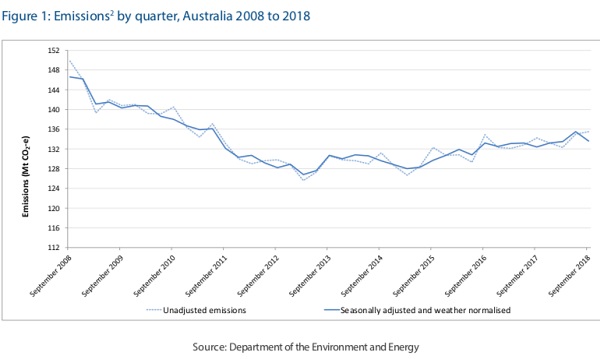

Posted late this morning at the SMH by Nicole Hasham is an article headlined Tony Abbott performs major backflip on withdrawing from Paris climate agreement. The article begins with:
There are other reports beginning to emerge on the clash this morning between Tony Abbott MP (current Member for Warringah) and challenger Zali Steggall, moderated by Sky News political editor David Speers. I heard some of it on the radio.
To my mind, Abbott is just a wrecker, flip-flopping to suit damaging his adversaries. It seems Zali may have his measure.
Interesting to see how this contest will end.
Brian, you say in your post:
Do you mean Craig Kelly MP, Federal Member for Hughes?
IEEFA report: Every two weeks a bank, insurer or lender announces new coal restrictions, dated Feb 26.
GM, Craig Kelly. I’ve never been good at names, and I’m not getting better. Some I can’t keep in my head for more than a few seconds.
My son Mark says he saw the debate, and only the Greens and Labor candidates knew anything about energy and climate change. He reckons Zali, beyond generalities, was an empty vessel . Doesn’t mean she won’t win, of course.
Ben Potter has an article Hunter Valley coal power plant ‘doesn’t fit the bill’: EnergyAustralia.
The plan to build a giant 2000 MW coal-fired power station in the Hunter Valley is being driven by a small businessman from Western Sydney with no known experience in the energy industry.
EnergyAustralia energy executive Mark Collette points out that old coal can have a role in modern power systems if it ramps up and down from 20% to 100%. However, new coal has to be run flat chat all the time to recoup the capital cost.
The $17.6 billion carbon indemnity risk figure is not a thought bubble from the Labor Party. It’s substantive piece of work done for the Australian Industry Group.
” a small businessman from Western Sydney with no known experience in the energy industry”
Could this be a distant relative of Mr Khemlani?
About time small business got a better run for its money in Australia! And he’s got guts this bloke. Career change. Risking his own money. Creating real jobs, not like those paper shuffling Green-tinged bureaucrats that have been holding the economy back. Bloke deserves one of those Knighthoods – has Prince Philip sent his one back yet, or do we have to print a new one?
Old King Coal was a merry old soul
And a merry old soul was he.
Ambi, it crossed my mind that it could be a stunt, to demonstrate that that you could get these things funded, and if the government is going to indemnify you for carbon risk, what’s to worry about?
Probably not, but this proposal shows how absurd the whole business of Coalition climate policy has become.
Brian (Re: MARCH 8, 2019 AT 11:37 PM)
Ben Potter’s article includes (bold text my emphasis):
I wonder whether this is another example of the Chinese government indirectly attempting to influence the outcome of another countries’ elections (i.e. in this case the NSW state election)? The timing is perhaps more than coincidental?
The AIG report you link to includes in the Executive Summary:
But why pay any attention to what the experts are telling us? Renewables are cheaper.
Renewables can be deployed faster.
Renewables have zero-carbon emissions.
Renewables with adequate storage are reliable.
It seems to me facts and evidence don’t matter for some people – they think they know better. And that road, if voters allow it (because they are also ill-informed), will likely lead to many people being hurt badly in the not too distant future due to the consequences emerging of the twin existential challenges of human-induced climate change and resource depletion (of petroleum oil and fossil natural gas – i.e. a post- ‘peak oil’ and post- ‘peak gas’ world) being ignored.
Here’s Phillip Coorey’s comments at the AFR headlined Coalition chaos: Abbott backflips, Turnbull attacks, Barnaby Joyce sharpens knife. It begins with:
A Wake-up Call from a Fossil Fuel Expert
What gets me is that supposedly astute businessmen and politicians are ignoring all the potential for making a squillion out of renewable energy sources and out of all the new technology aimed at reducing electricity and fossil-fuel consumption.
What’s the matter? Are they terrified of making money whilst improving our overall standard of living? They are as silly as their defunct predecessors. “If Man was meant to fly, God would have given him wings” and “If a man travels faster than a horse gallops, dreadful things happen to his organs”
Here is a spanner (maybe) for the discussion. I was late evening dozing before the TV and started hearing/seeing a YouTube talk by a guy called Jeremy Rifkin. He took an historical path explaining three common elements of the first and second industrial revolutions. He goes on to propose we are on the cusp, or have indeed started, a third industrial revolution. You can see his talk here:
https://www.youtube.com/watch?v=5mQj574Cv_k
There is also his book ISBN13 9780230341975 (6th Ed)
I need to look at this carefully because he places the “new” three common elements onto a platform he says is “the internet of things” (IoT). Based on what Rifkin says my understanding of the IoT totally understates what it is. I thought it meant you could switch the home air conditioning on or off from your phone, simple convenience stuff. Not so.
The booksellers precis gives some insight into how this all works, according to Rifkin. See: https://www.bookdepository.com/Third-Industrial-Revolution-Jeremy-Rifkin/9780230341975
Why raise it here? We are talking energy and the future of energy generation. If Rifkin is right, the IoT may be a much bigger player/component than I ever guessed. Maybe it should be part of the discussion.
Geoff H, I would listen to Rifkin. He does this futures stuff for a living and used to do a column I think for Business Review Weekly before it went down the crapper.
There’s a couple of other links I’ll try to dig up when I get time.
Graham Bell (Re: MARCH 9, 2019 AT 1:35 PM)
I would suggest ignorance, lack of vision/short-term thinking, together with propaganda from vested interests and misinformation (or non-reporting) from some sections of media.
I think most business people are too busy to research emerging trends. Most probably don’t have any/little vision, are risk-averse and probably are constrained by ‘groupthink’/’tribalism’ – most economists couldn’t see the global financial crisis coming.
There’s a paywalled story in The Oz online claiming that
Mr Morrison has slapped down Barnaby Joyce’s call for a government-subsidised coal-fired power station in central Queensland.
(I heard Mr Joyce’s interview with Fran Kelly this morning. It was a wild ride. Mr Joyce sounded a little over-excited. He called himself “the elected deputy PM”. My view is that he once, for a while, held that position)
GM:
Depends on what industries you are talking about. Some, like IT, have to innovate rapidly and dramatically to survive. Others, like steelmaking, innovate less dramatically but still innovate constantly to improve the performance of what they have. (And yep, there are some businesses that don’t innovate and go out of business.)
Risk management is a part of any durable business.
Never worked for any business that was not putting some resources into researching future trends and the changing business environment that had to survive in.
On my recent trip from sydney to London I sat next to a young British guy who started his academic life doing aeronautical engineering but finished as a statastician, and was on his way home from Auckland after consulting to New Zealands equivalent of the AEMO. I spent some time extolling the advantages of Hans Rosling’s Mind the Gap software for animating statistics. Then by coincidence I was standing in the immigration que at Amsterdam and struck up a conversation with another guy from Melbourne who was heading to Oslo to consult there on Renewable Energy matters. The second guy was very interested in the skills of the first guy, so I have passed on the connections. If you considered the probabilities of this set of spontaneous “meetings”, you would have to conclude that the world has to be swarming with people concerned with and promoting Renewable Energy.
That’s remarkable, BilB.
It shows also how people with knowledge flit around the world at times to put it to use.
….. because there are companies who can afford to pay for them to flit because the international flitters’ knowledge and advice will give a company some financial advantage far outweighing the price of airfares and consultancy fees…..
. …all travelling coach, Ambi. These are your basic woking flitters, not the Fatter Flattered Flitters.
Thanks BilB.
So you are also a Flitter Twitcher?
Your knowledge of species is admirable.
Meanwhile, Minister Angus Taylor says the Federal govt still has ten coal-based energy developments under assessment. He says the govt will underwrite only “viable” projects.
Ambigulous (Re: MARCH 12, 2019 AT 5:32 PM)
It seems Simon Holmes à Court heard Matt Canavan on the ABC 4pm news yesterday say he thought there would be new coal-fired power built in Australia, and Holmes à Court has offered 10-to-1 odds that won’t happen.
Mike Cannon-Brookes has chimed in on twitter to match those odds:
Meanwhile, per CoalSwarm’s Global Coal Plant Tracker (GCPT) data, it appears that although global operating coal-fired capacity has gradually increased (in the period from 2014 through 2018), under construction capacity has shrunk significantly and planned capacity has shrunk rapidly. See the bar chart in my Addendum A (or 9.1 Supplementary) to my Submission (#09) to the Australian Parliament Senate Select Committee into Fair Dinkum Power.
Posted yesterday evening on the SMH is an article by Eryk Bagshaw and Nick Bonyhady headlined ‘Change now or pay later’: RBA’s stark warning on climate change. The article begins with:
First it was Geoff Summerhayes, Australian Prudential Regulation Authority executive, warning about climate change. Now it’s the Reserve Bank of Australia. Who’s next?
The list stretches back a long way too: PM Rudd, PM Gillard, Dr Bob Brown, Mr Al Gore, PM Howard, Mr Garnaut, IPCC, leaders in Europe, the Pacific, the Americas….
Why, even as long ago as Margaret Thatcher (who studied chemistry at University) warnings were sounding. In those days we called it “atmospheric warming” or “global warming”.
For different reasons, CSIRO worked on developing rooftop solar hot water gizmos in the early 1960s.
Earlier this morning, 2GB’s Ray Hadley clashed with Peter Dutton over coal-fired power stations.
Ray pushed Federal Home Affairs Minister Dutton to clarify his position on coal.
The turmoil within the COALition continues.
Lisa Cox in the Guardian Australia has an article “Australia’s annual carbon emissions reach record high”.
We’re going in the wrong direction, though it may well be at a canter.
“The report shows emissions from the electricity sector continue to decline due to large-scale renewable energy projects.
But those gains were cancelled out by increases in emissions from all forms of transport, stationary energy (fuels burnt in equipment or plants not involved in electricity generation) and fugitive emissions (leaks from other activities such as methane from a coalmine).”
Ambigulous, thanks for your link to the Lisa Cox article. I’ve included this graph in a new post School strike 4 climate:
Take away tree clearing and the trend is up.
And what we need is a downward trend in every sector, however defined.
Cheers
Posted Mar 19 at IEEFA.org is an article by Tim Buckley headlined IEEFA update: First Chinese major joins over 100 global financial institutions restricting coal finance. It begins with:
There’s also this:
Governments need to plan for a likely rapid transition.